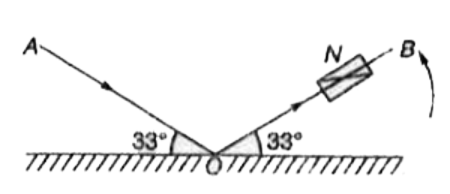A beam of unpolarised ligth is made to fall,from air ,on its boundary with another transparent medium of refrective index μ.The reflected beam is viewed through a rotating analyser.Show on a graph,the variation of intensity of light trasmitted through the analyser with the angel between the pass axis of the analyser and the direction of the reflected beam.Solution in Punjabi
Step by step video & image solution for A beam of unpolarised ligth is made to fall,from air ,on its boundary with another transparent medium of refrective index mu.The reflected beam is viewed through a rotating analyser.Show on a graph,the variation of intensity of light trasmitted through the analyser with the angel between the pass axis of the analyser and the direction of the reflected beam. by Physics experts to help you in doubts & scoring excellent marks in Class 12 exams.
Updated on:21/07/2023Topper's Solved these Questions
- Polarisation of LightBOOK - MODERN PUBLICATIONCHAPTER - Polarisation of LightEXERCISE - EXERCISE
50 Videos
- Particle Nature of RadiationBOOK - MODERN PUBLICATIONCHAPTER - Particle Nature of RadiationEXERCISE - EXERCISE
94 Videos
- RadioactivityBOOK - MODERN PUBLICATIONCHAPTER - RadioactivityEXERCISE - EXERCISE
71 Videos
Similar Questions
What do you understand by polarisation of light ?Describe an experiment to demonstrate transverse nature of light.
View SolutionWhat is photoelectric effect? State it laws?
View SolutionWhat is meant by radioactive substance?
View SolutionA beam of light is incident on a glass slab (μ=1.54) in a direction as shown in the figure. The reflected light is analysed by a polaroid prism. On rotating the polaroid, (tan57∘=1.54)

View SolutionA parallel beam of monochromatic unpolarised light is incident on a transparent dielectric plate of refractive index 1√3. The reflected beam is completely polarised . Then the angle of incidence is
View SolutionAt what angle should an unpolarised beam of light he incident on a medium of refractive index sqrt(3) so that the reflected beam is completely polarised ?
View SolutionAn unpolarised beam of intensity 2A2 passes through a thin polaroid. Assuming that no light is absorbed by the polaroid, the amplitue of the emergent beam will be
View SolutionA light beam is incident from air to a glass slab at Brewster's angle. A polaroid placed in the path of the reflected beam is being rotated about an axis passing through the centre and perpendicular to the plane of the polariod.
View Solutionएक प्रकाश किरण μ अपवर्तनांक वाले माध्यम से गुजरती हुई। ऐसे माध्यम की सतह पर आपतित होती है जो वायु में 45∘ के कोण पर स्थित है। निम्न में से μ का कौन-सा मान होगा जिसके लिए किरण पूर्ण आंतरिक परावर्तित हो -
View Solutionकिसी माध्यम से प्रकाश हवा में प्रवेश करता है, तो प्रकाश किरण का पूर्ण आन्तरिक परावर्तन होता है। इस समय माध्यम से हवा में क्रान्तिक कोण 30∘ है। माध्यम का अपवर्तनांक ज्ञात करो ।
View SolutionA beam of light is incident on a glass slab (μ=1.54) in a direction as shown in the figure. The reflected light is analysed by a polaroid prims. On rotating the polaroid (tan57∘=1.54)

View SolutionA beam of light is passed through a polaroid and the latter is rotated with the beam of light as axis. The intensity of the emergent light varies between a maximum and a minimum.Then the light used is :
View SolutionA soldier directs a laser beam on an enemy by reflecting the beam from a mirror. If the mirror is rotated by an angle θ, by what angle will the reflected beam rotate?
View SolutionPlane polarised light is incident on an analyser. The intensity then becomes three fourth. The angle of the axis of the analyser with the beam is
View Solutionचित्र में दर्शाये अनुसार प्रकाश किरण पुँज AO एक काँच की पट्टिका (μ=1.54) पर आपतित है। परावर्तित किरण OB को निकॉल प्रिज्म से गुजारा जाता है। निकॉल प्रिज्म को घुमाने पर हम पाते है कि

View SolutionAn unpolarised beam of light of intensity l0 falls on a poloroid. The intensity of the emergent beam is
View Solution
